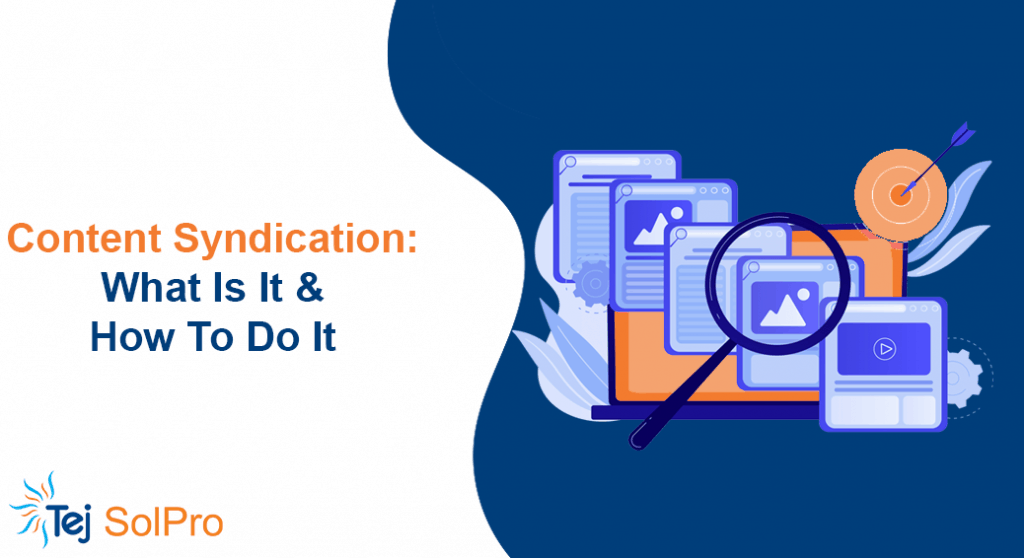In today’s saturated digital landscape, creating great content marketing for B2B indurstries is only half the battle. The real challenge lies in getting that content in front of the right people at the right time. While most businesses focus on publishing content on their own websites and social channels, they’re missing out on a powerful strategy that can exponentially amplify their reach: content syndication.
Content syndication isn’t just about republishing your articles it’s a strategic approach to distribution that can transform your business’s visibility, establish your authority in your industry, and generate high-quality leads at scale. Whether you’re a B2B SaaS company looking to reach enterprise decision-makers through B2B digital marketing or a B2B manufacturer trying to connect with your target audience, syndication offers a path to growth that doesn’t require you to reinvent the wheel.
Contents
- 1 What Is Content Syndication?
- 2 Why Content Syndication Matters for Your Business
- 3 How Content Syndication Works (With Business Context)
- 4 Types of Content Syndication (Business-Friendly Formats)
- 5 Where Should You Syndicate Content?
- 6 What Type of Content Works Best for Syndication?
- 7 Key Benefits of Content Syndication for Businesses
- 8 How to Start with Content Syndication?
- 9 Common Mistakes Businesses Make (And How to Avoid Them)
- 10 When Does Syndication Actually Convert to Leads?
- 11 Content Syndication vs Paid Ads vs Organic SEO
- 12 Final Thoughts
What Is Content Syndication?
Content syndication is the practice of republishing your original content on third-party platforms to reach new audiences and amplify your message. Think of it as giving your best content a second, third, or even fourth life by placing it where your ideal customers are already spending their time.

How It’s Different from Guest Posting and Paid Ads
Unlike guest posting, where you create new content specifically for another platform, syndication involves taking your existing high-performing content and adapting it for distribution across multiple channels. And unlike paid advertising, syndication focuses on providing value first rather than pushing for immediate conversions.
Here’s the key distinction:
- Guest posting: You write new content for someone else’s platform
- Paid ads: You pay to interrupt people with promotional messages
- Content syndication: You share your valuable content on platforms where your audience already consumes information
Why It’s Strategic Distribution, Not Duplication
Content syndication isn’t about copy-pasting the same article everywhere. It’s about strategically adapting your content to fit different platforms and audiences while maintaining your core message. When done correctly, syndication enhances your B2B SEO efforts rather than competing with them, builds brand recognition across multiple touchpoints, and creates a comprehensive content ecosystem that works together.
Why Content Syndication Matters for Your Business
Visibility: Be Seen Where Your Audience Already Is
Your potential customers aren’t just hanging out on your website waiting for your next blog post. They’re reading industry publications, browsing LinkedIn, consuming newsletters, and engaging with content across dozens of platforms. Content syndication allows you to meet them where they are rather than hoping they’ll find you through traditional B2B marketing strategies.
Authority: Build Credibility by Showing Up on Trusted Platforms
When your content appears on respected industry publications or well-known platforms, it borrows credibility from those sources. A bylined article on Forbes or Harvard Business Review carries more weight than the same content published only on your company blog. This credibility transfer is one of syndication’s most powerful benefits for B2B brand building.
Trust & Leads: More Awareness Leads to More Qualified Leads
The more touchpoints a prospect has with your brand, the more likely they are to trust you when they’re ready to make a purchase. Content syndication creates multiple impression points, keeping your brand top-of-mind throughout the buyer’s journey. This increased awareness naturally translates to more qualified B2B lead generation opportunities.
How Content Syndication Works (With Business Context)
Content syndication follows a systematic process that can be broken down into four key steps:
Content Selection
Choose your highest-performing, evergreen content that provides genuine value to your target audience. This might be your most-shared blog posts, comprehensive guides, or industry insights that remain relevant over time and support your B2B content strategy.
Partner Platform Identification
Research and identify platforms where your target audience is most active. This could include industry publications, content aggregators, professional networks, or partner websites that align with your B2B marketing automation goals.
Distribution Strategy
Adapt your content for each platform while maintaining your core message. This might involve:
- Adjusting the headline for the platform’s audience
- Modifying the introduction to fit the platform’s style
- Adding platform-specific calls-to-action
- Ensuring proper attribution and canonical tags for technical SEO for B2B
Performance Tracking
Monitor key metrics such as traffic, engagement, lead generation, and brand mentions to measure the success of your syndication efforts and optimize your B2B content marketing strategy over time.
Types of Content Syndication (Business-Friendly Formats)
Self-Syndication (LinkedIn, Medium, etc.)
This involves republishing your content on platforms you control, such as LinkedIn Articles, Medium, or industry-specific communities. It’s the easiest way to start and gives you complete control over timing and formatting while supporting your B2B social media marketing efforts.
Third-Party Syndication (Forbes, TradePubs, etc.)
Working with established publications to feature your content. This often requires relationship building and may involve editorial review, but offers the highest credibility boost for your B2B thought leadership initiatives.
Paid Syndication (Taboola, Outbrain)
Using content discovery platforms to promote your articles through sponsored content placements. This combines the reach of syndication with the targeting capabilities of B2B paid advertising.
Influencer Amplification (via partnerships)
Collaborating with industry influencers to share and discuss your content with their audiences. This adds a personal endorsement element to your syndication strategy and supports B2B influencer marketing.
Co-marketing Syndication (collaborations or joint ventures)
Partnering with complementary businesses to cross-promote each other’s content, expanding reach while sharing resources and costs a key component of B2B partnership marketing.
Where Should You Syndicate Content?
Platforms that are based on your industry. For example:
- Finance & FinTech: MarketWatch, Seeking Alpha, Financial Planning Magazine
- Technology: TechCrunch, VentureBeat, InfoWorld
- Real Estate: Inman, RealtyTimes, National Association of Realtors publications
- Healthcare: Healthcare IT News, Modern Healthcare, Becker’s Hospital Review
- Marketing: MarketingLand, Content Marketing Institute, HubSpot Blog
Syndication Platforms vs. Niche Partner Sites
Broad syndication platforms like LinkedIn, Medium, and industry aggregators offer wide reach but less targeted audiences. Niche partner sites provide more qualified traffic but require relationship building and often have stricter editorial standards that align with B2B content governance.
Email Newsletters, B2B Aggregators, and Podcast Show Notes
Don’t overlook these often-missed opportunities that can enhance your B2B email marketing and B2B podcast marketing efforts:
- Industry email newsletters with high open rates
- B2B content aggregators that curate industry insights
- Podcast show notes that can feature your written content alongside audio discussions
What Type of Content Works Best for Syndication?
Blogs
Well-researched, evergreen blog posts that provide actionable insights perform exceptionally well across syndication channels and support your B2B blogging strategy.
Industry Reports
Original research and industry analysis establish thought leadership and are highly sought after by syndication partners, making them perfect for B2B research marketing.
How-to Guides
Step-by-step tutorials and educational content have universal appeal and tend to generate strong engagement across platforms while supporting educational marketing for your industry.
Whitepapers and Ebooks
Condensed versions or key insights from your gated content can drive traffic back to your full resources, supporting your B2B lead magnets strategy.
Case Studies
Real-world examples and success stories resonate with audiences and demonstrate your expertise in action, making them ideal for marketing your case studies and gather clients from it.
Explainer Videos and Webinars
Visual content can be repurposed into written articles or accompanied by detailed transcripts for syndication, supporting your B2B video marketing efforts.
Key Benefits of Content Syndication for Businesses
Increased Inbound Traffic and Lead Quality
Syndicated content creates multiple pathways back to your website, often bringing more qualified visitors who are already interested in your expertise a key component of B2B inbound marketing.
More Brand Mentions and Backlinks (SEO + Authority)
Each syndication placement potentially generates backlinks and brand mentions, improving your search engine rankings and online authority through B2B link building and B2B SEO services.
Stronger Remarketing Audiences
Syndicated content helps you build larger, more diverse remarketing audiences across multiple platforms, improving your B2B retargeting and paid advertising efficiency.
Builds Trust Without Cold Selling
Instead of interrupting prospects with sales messages, syndication allows you to provide value first, building trust and credibility naturally a cornerstone of B2B trust-based marketing.
How to Start with Content Syndication?
Set Goals: Traffic, Brand Awareness, Lead Gen?
- Define clear, measurable objectives that align with your B2B marketing goals
- Align syndication strategy with overall business goals
- Set realistic timelines for results
Choose Content: Evergreen, Educational, or Lead Magnets
- Audit your existing content for syndication potential using B2B content audit principles
- Prioritize high-performing, evergreen pieces
- Ensure content provides genuine value to target audiences
Pick Platforms: Free, Paid, and Partner-Based
- Start with free platforms to test your strategy
- Gradually incorporate paid syndication for scale
- For partner-based platforms you need to build relationships with key industry publications
Track: Use UTM, CRM, and Analytics
- Implement UTM parameters for all syndicated content
- Set up conversion tracking in your CRM using B2B marketing analytics
- Monitor both quantitative and qualitative metrics
Optimize: Based on What Performs
- Regularly review performance data using B2B marketing metrics
- Adjust content selection and platform mix
- Refine your approach based on results
Common Mistakes Businesses Make (And How to Avoid Them)
Republishing Without Canonical Tags
Mistake: Publishing identical content without proper SEO attribution
Solution: Always use canonical tags pointing to your original content to avoid duplicate content penalties and maintain B2B SEO best practices
Syndicating Everything (Not All Content Qualifies)
Mistake: Attempting to syndicate every piece of content you create
Solution: Be selective only syndicate your highest-quality, most valuable content that aligns with your content quality standards
Skipping Performance Tracking
Mistake: Publishing content without measuring results
Solution: Implement comprehensive tracking from day one using B2B marketing measurement tools to understand what’s working
Not Aligning with Brand Messaging
Mistake: Allowing syndicated content to stray from your brand voice
Solution: Develop clear brand guidelines for syndicated content and review all adaptations to maintain your brand consistency
When Does Syndication Actually Convert to Leads?
Examples: A Niche Blog Leading to Inbound Inquiry
Consider a cybersecurity company that syndicates a detailed guide about data breach prevention. When this content appears on a respected IT publication, it reaches IT directors who are actively concerned about security threats. The credibility of the publication combined with the practical value of the content leads to direct inquiries from qualified prospects through B2B demand generation.
Role of Call-to-Actions in Syndicated Content
Effective syndicated content includes subtle but clear calls-to-action that guide readers toward the next step in your B2B sales funnel. This might be:
- Learn more about our comprehensive security audit process”
- “Download our complete cybersecurity checklist”
- “Schedule a free consultation to discuss your specific needs”
Importance of Linking to Gated Assets (Lead Magnets)
Syndicated content should serve as the top of your funnel, directing interested readers to gated resources like whitepapers, webinars, or tools that capture their contact information through B2B lead capture mechanisms.
Content Syndication vs Paid Ads vs Organic SEO
When to Use What
- Use syndication when you want to build authority and reach new audiences with existing content as part of your B2B content distribution strategy
- Use paid ads when you need immediate results and have budget for ongoing B2B PPC campaigns
- Use organic SEO when you’re building long-term, sustainable traffic growth through B2B organic search
How Syndication Can Boost Both SEO and Paid ROI
Content syndication enhances your SEO for B2B efforts by generating backlinks and brand mentions while providing more touchpoints for remarketing campaigns, ultimately improving your B2B advertising ROI and B2B marketing efficiency.
Final Thoughts
Content syndication isn’t about quantity it’s about quality visibility. The goal isn’t to republish your content everywhere possible, but to strategically place your most valuable insights where they’ll have the greatest impact on your target audience through B2B strategic marketing.
If you want to stay top-of-mind without interrupting people, syndication does the job. It allows you to provide value consistently across multiple touch-points, building trust and credibility over time rather than through aggressive sales tactics a key principle of B2B relationship marketing.
Businesses that prioritize value-based visibility gain faster trust and better leads through B2B trust marketing. By sharing your expertise where your audience already consumes information, you’re not just building brand awareness you’re establishing yourself as a trusted advisor in your industry through B2B thought leadership marketing.
The key to successful content syndication lies in understanding that it’s a long-term strategy that compounds over time. Each syndicated piece builds on the last, creating a comprehensive presence that keeps your brand visible throughout your prospects’ decision-making journey. When they’re ready to make a purchase, you’ll be the trusted expert they turn to first.
Start small, measure everything, and gradually expand your syndication efforts as you learn what works best for your B2B marketing optimization. The investment in time and resources will pay dividends in increased visibility, enhanced authority, and higher-quality leads that convert at better rates than traditional B2B marketing channels.






